|
Original
Monarch factory, built in 1909.
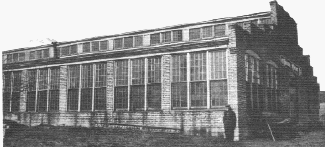
The recent announcements about the future of Monarch have
stirred much discussion about the company, its future, and the efforts of community
leaders to keep the core of Monarch business in this city. It appears that the final
chapter in the history of this once mighty enterprise is being written. Perhaps it is
appropriate to pause now and consider the Monarch story at this time. It is as fine an
example of a mutually beneficial relationship between a company and a community as there
is. Success stories such as Monarch do not happen by accident. Commitment to a common
purpose and sacrifice by all of the members of the 'Monarch family', as it was called for
many decades, made it all possible. This is the story of the Monarch men and women, and
what they were able to achieve.
The editor of the Sidney Journal thought enough of the story to give it front
page coverage. "A New Factory Is Secured 'for Our City By The Untiring Efforts Of
Our Leading Citizens," the headline in the June 25, 1909 edition read. Joining I. H. Thedieck, Sidney's leading
retailer, in establishing the enterprise were many of the major players in the Sidney
business community at the time: L. M. Studevant,
A. C. Getz, A. J. Hess, J. O. Amos, E. J. Griffis and W. H. Wagner. The leadership and
original idea came from Thedieck, however. As the Journal editor noted: "The
credit for this new factory belongs to Mr. Thedieck who has had numerous offers from other
cities but his desire to see Sidney grow larger and greater would not permit him to
consider a deal from outsiders, hence the locating it here."
Monarch was to truly be a product of the community. Thedieck arranged for a driver and
wagon to circle the courtsquare for the purpose of offering stock in the new venture to
residents of the town. Within a few weeks, all the stock had been subscribed, and the
company was ready to begin the challenges of an uncertain future.
Thedieck, who was married to Ida Wagner, had
loaned funds earlier to Ida's cousin, A. P. Wagner, for the operation of A. P. Wagner Tool
Works in Detroit. When Wagner failed to pay him, and the business failed, Thedieck
foreclosed on Ida's cousin, claimed the machinery of the business, and exchanged it for
$25,000 in Monarch stock. The Commercial Club,
the forerunner of today's Chamber of Commerce, arranged for a building site, and within a
few months, production began. The business started with 15 employees, who were paid
between 5 cents and 35 cents per hour for a 55 hour week. The company concentrated on the
production of engine lathes. Business was slow, and Thedieck often had to make personal
loans to meet payroll. Perhaps the most important decision in Monarch's history was made
in the spring of 1912, when Thedieck hired his son in law, Wendell Whipp, to serve as
general manager.
With no prior knowledge about machine tools, Whipp learned on the job.
He became a persuasive and aggressive salesman. Long before his retirement from Monarch in
April of 1947, Whipp became the personification of Monarch and its approach to quality
products and the treatment of employees as 'family.' He insisted on quality work, for
which he paid top wages.
By 1915, under Whipp's leadership, Monarch began to prosper. He instituted a profit
sharing plan that year for all employees. Within a year, top factory workers were
receiving ten percent of their base pay in a bonus - an unheard of generosity for the
time. By 1917, Whipp had in place the first group life insurance for employees in Ohio.
Whipp believed deeply in both personal and corporate support for community activities.
After the local Red Cross chapter was organized in 1917, an initial fund drive was held.
Monarch contributed $500. The next largest corporate donation was $25. The biggest nemesis
of the machine tool industry in this country has been the boom and bust cycle associated
with economic periods of growth and decline. This problem was to be greatly accentuated by
huge government purchases during times of war,
and the dumping of excess machines on the market by the government afterwards. Monarch
first faced this problem during World War I. Employment increased from 55 to 258, with a
resulting increase in business, but by 1924, only 118 workers remained. Whipp sought to
smooth out the up and down cycles of the business by constantly working on the research
and development of new products for the domestic market.
Whipp also saw the wisdom in securing foreign orders whenever possible in order to
diversify the company's customer base. Large shipments of lathes to the French and British
governments before the entrance of the U. S. into World War I played an important role in
the subsequent Allied victory. From the beginning, Whipp imbued a sense of civic
responsibility in all Monarch employees. During World War I, all 258 employees subscribed
to war bonds, and raised more money than any other Sidney business. To set a proper
example, Whipp and Thedieck each purchased over $1,600 worth of bonds. Whipp and the
others were also involved in numerous community activities. Fred Dull, one of the most
beloved of all Monarch managers, labored constantly on behalf of Kiwanis, the Sidney Civic
Association, parks and recreation projects, and his church.
Whipp concentr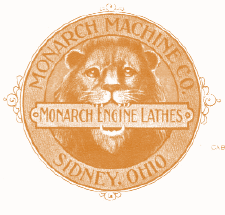 ated
on making sure every employee felt a part of the 'Monarch Family.' He initiated a program
in 1918 so that employees could borrow money to purchase homes. The first of many Monarch
family picnics was held in 1919. To assure good attendance, Whipp paid employees a half
day's pay for bringing their families to the Saturday affair. On occasion, Whipp would
hire a train to transport Monarch employees and family members. ated
on making sure every employee felt a part of the 'Monarch Family.' He initiated a program
in 1918 so that employees could borrow money to purchase homes. The first of many Monarch
family picnics was held in 1919. To assure good attendance, Whipp paid employees a half
day's pay for bringing their families to the Saturday affair. On occasion, Whipp would
hire a train to transport Monarch employees and family members.
However, the key to
fostering the atmosphere of teamwork that Whipp wanted was his personal touch. He always
knew the latest news about each employee, and he constantly reminded them that their
contribution was critical to Monarch's success. One retiree remembered: "He was
one of the best guys I ever knowed. That guy would do anything for you." Such
management loyalty resulted in many employees working at Monarch for over forty years.
Typical of these were Al Sherman and Jerome Raterman. Both started with Monarch during the
war and worked there for over four decades, with Sherman becoming vice-president and
Raterman president.
The feeling of unity that Wendell Whipp generated among his troops stood the company in
good stead during the inevitable bad economic times that always seemed just around the
corner. Following World War I, employment held steady until 1921, when a vicious recession
hit. In one week, the workforce at Monarch was reduced from 187 to 24 people. Many of
those laid off worked elsewhere only until the call came from Monarch that they were
needed again.
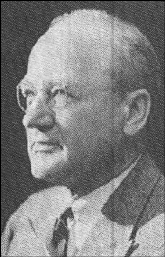
Wendell Whipp, President, 1931-1947
Even in the bad times, Whipp and
the others looked to the future. Spending on research continued even in the 1920's when no
new orders were coming in the door. Faithful and talented employees were at the center of
every Monarch product innovation. Pete Bickel and Fred Dickas produced the first
helical-geared lather headstock in America in 1924. "Bam" Albers developed many
innovations. In an effort to make his own machine work more easily, Albers designed a
series of levers. Whipp walked by his station one day, and after Albers explained how they
worked, Whipp exclaimed, "My God, Bam, you've got it!" Another Monarch
innovation had been born.
Such in-house creativity resulted in Monarch being a leader
at the national machine tool show each year. For example, at the 1929 show, Monarch
displayed a lathe that could operate quietly at three times the speed of competitors'
lathes. One company employee would later recall: "We had the crowd. The industry
couldn't believe it."
Whipp and his management team did not stop with product development. Monarch was a
leader in the field of machine tool advertising, developing its first product film in
1927. Monarch management, at Whipp's insistence, decided early on to develop and maintain
the highest standard of quality in the industry. To the amazement of its competitors, the
Monarch product guarantee was simple and complete. Every lathe was guaranteed "to the
complete satisfaction'" of the purchaser. To one customer, Whipp suggested that if he
wanted a stronger guarantee, "Write it yourself. Ten to one we will accept it, and
bind ourselves to it absolutely."
As a result of its growing reputation for quality products, Monarch began to develop a
customer base in the automotive and other key industries. Ford, General Motors, and
Chrysler purchased dozens of lathes. Electrical giants such as General Electric and
Westinghouse also used Monarch products. The 1920's and 30's saw significant labor unrest
grip the nation. Largely because of Wendell Whipp's personal relationship with his
employees, Monarch continued to prosper, without labor problems and without a union. To
Whipp, leadership meant leading by personal example. When the Great Depression descended
over the land beginning with the stock market crash in October of 1929, Monarch's business
began to evaporate along with everyone else's. At Whipp's suggestion, top management took
pay cuts in order to help keep the doors open for business. He accepted 33% less pay, the
largest cut of any employee.
Naturally, the price of Monarch's stock dropped after the market crashed. A number of
employees had purchased stock in the company, only to see it decline substantially in
value. To ease their personal financial hardship, Wendell Whipp and Fred Dull purchased
some of the stock back for far more than its market value.
The Depression years strained even the solid foundation Monarch had built since 1909.
Although employee hours per week were cut from 55 in the late 20's to a low of 14 by the
summer of 1932, large layoffs were an economic necessity. The Monarch Family dwindled to
16 employees. Once again, however, Whipp had the foresight to continue with product
development to the extent possible with the existing cash reserves, while his competitors
concentrated on keeping the doors open for business. As a result, when business conditions
improved in the mid 1930's, Monarch was ready to hit the deck running with ten new product
designs.
Even the Monarch Keller lathe,
the world's first contour turning lathe, and the 'Shapemaster" were two of the most
important new products. Other Monarch innovations throughout the 1930's helped forge a
market leadership position for the company. The 'EE' lathe, which would prove to be the
best selling lathe in the history of the company, made its debut in 1939.
By 1937, 500
employees were back home at Monarch. With its recent product developments, the company was
poised to write its greatest chapter. As a prelude to the industrial expansion at the
outset of World War II, Monarch sought and obtained huge foreign orders for its machines.
Russia and many European continent countries purchased hundreds of lathes. By 1939,
foreign sales exceeded domestic sales for the first time in Monarch's history.
Whipp prepared for Monarch's participation in the war he knew that his country could
not avoid. In June of 1939, the company dedicated another building addition. This one
housed the employee's cafeteria, an auditorium, and classrooms for instructional purposes.
The open house attracted 8,500 people, and again demonstrated the commitment the people of
Sidney had for Monarch and its employees.
The relationship between Monarch and the community was inseparable. Many young Sidney
boys got their first job at 'the Monarch'. Louis F. 'Bud" Kreitzer began there as a
high school co-op student in 1929, and eventually became vice-president in a career that
spanned 45 years. The increase in business that Whipp had expected, and for which he
planned, began in early 1940, but it dwarfed anything about which he had ever dreamed.
President Roosevelt announced plans in early 1940 for a two billion dollar defense budget,
but by the end of the year, he had increased that figure to 10.5 billion. The orders from
the government increased from a trickle to a torrent.
With young men going off to war, and every factory hiring, Monarch soon faced a
critical shortage of workers. Whipp saw the problem developing, and turned to an untapped
resource: housewives. In an experiment which other industry leaders around Ohio and
elsewhere watched closely, Whipp successfully trained and employed over 500 women in
virtually every aspect of factory work. Led by Virginia Oldham, Monarch's first female
shop worker, the females soon demonstrated that they could work side by side with their
male counterparts.
By the end of 1942, the Monarch family had grown to 2,700 employees and their families.
In most cases, the family took a back seat out of necessity. For a year and a half during
this time, every employee got only one day off every three weeks. Not one worker took a
vacation. Monarch's payroll was three times as large as the payroll of all Sidney
businesses combined during the boom year of 1929 prior to the Depression. Orders of
Monarch products totaled $147,000 in 1932, and by the end of the next decade, sales had
risen to nearly $30,000,000. As usual, Whipp decided to share the fruits of the employees'
hard work with them. Bonuses for 1942 ranged up to ten percent of the yearly wages.
The efforts of Monarch's
employees received national recognition. In October of 1941, the company received its
first coveted 'E' pennant from the U. S. Navy for outstanding contributions to the defense
program. Senior employees Charlie Buehler and Philber Abe accepted the pennant for the
company. By the end of the war, its pennant contained five stars - a record unmatched by
any other Ohio machine tool company.
Wendell Whipp also recognized that seven day work
weeks created additional problems, so he redoubled his efforts to solidify the bond
between his employees and Monarch. Sports teams, funded by Monarch, flourished. Twelve
softball teams competed in their own league, Other organized sports included bowling,
fencing, casting, golf, horseshoes and archery. The Monarch Glee Club entertained at
social events around the community.
The Monarch Family was larger and operated as a more cohesive unit than ever before.
When the employees got behind a community effort, it was bound to succeed. Led by Whipp's
example, virtually every employee car pooled to save tires and gas. When management
distributed a booklet on planting a 'Victory Garden', to help conserve food supplies,
Monarch employees led the way.
Whipp continually praised his employees. In a Christmas letter delivered to the
employees at the end of 1942 he stated: "You men and women of Monarch were quick
to meet the challenge to freedom. You learned to do without many things. But most
important of all, you have worked...Monarch will meet Washington's quota on lathes --
thanks to the team-work of Monarch men and women. To all of you...I offer my deepest
appreciation."
During the war, Monarch employees worked on numerous projects that were critical in the
effort to win the war. The 40 millimeter Bofors anti-aircraft gun, which helped turn the
tide against the dive-bombing Japanese zeroes in the Pacific, contained important parts
manufactured here. Monarch also manufactured the power take off units for the aircraft
engine used in the British Lancaster and Halifax bombers. Several contracts involved
making lathes that were shipped to a mysterious 'Little Brown Jug' address. Only after the
war did company officials find out that the lathes went to the Manhattan project- which
resulted in the production of our first atomic bomb.
Government orders dropped substantially in the latter part of 1943, and Monarch
officials feared that once again the company was headed for the 'bust' end of the boom and
bust cycle so typical for the machine tool industry.
Besides dealing with the painful conversion to a peacetime economy, and a market
flooded with excess machine tools, Monarch and Whipp had to grapple with a new problem.
Wage and price controls imposed during the war irritated millions of American workers. A
tide of unionism swept the country. Whipp countered with wage increases that totaled 30
percent over two years, and the establishment of an incentive pay program. It would not be
enough. Despite his best efforts, company employees followed the union trend. On June 8,
1944, the employees voted for the United Electrical, Radio, and Machine Workers of America
to become their bargaining representative. As an inevitable result of the loss of the
direct relationship with his workers, Whipp's 'family' would never be the same.
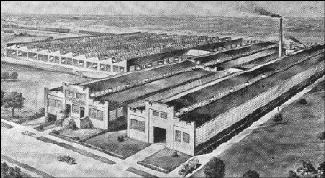
Although Monarch was to have its share of difficulties with
the union and several work stoppages here, similar problems with its customers and
suppliers in the 1940's and 50's created more problems. In 1946, for example, the
workforce was cut from 1,000 to 750 because the company could not get the raw materials it
needed for production.
The Korean War gave rise to another jump in Monarch orders.
By the end of 1952, over 1,400 workers once again reported to work at the Oak Street
facility. During this era, Jerome Raterman shaped the fortunes of Monarch. He replaced
Whipp as president in 1947, but Whipp continued to act in as advisory capacity. Raterman
served until Kermit Kuck succeeded him in 1961.
It would be impossible to overestimate the impact Monarch had on our community through
the first half century of its existence. Jobs created, taxes paid, and charitable
activities supported are but a few of the more tangible measures. Wendell Whipp, Fred Dull
and Jerome Raterman had a more enduring legacy in mind when they formed The Monarch
Machine Tool Company Foundation in 1952. Over the last 45 years, this foundation has
supported virtually every major community project, including expansions programs
associated with Wilson Memorial
Hospital, the YMCA, Sidney Schools, Lehman
High School, Dorothy Love, and the Amos Memorial Public
Library. In the last 5 years alone, foundation gifts have exceeded one million
dollars.
In the decade that followed the end of the Korean War, change was a constant at
Monarch. Everyone connected with Monarch mourned the loss of Wendell Whipp in a 1957
boating accident. When Fred Dull passed away the next year, Monarch had lost its two most
revered leaders.
Meanwhile, new president Kermit Kuck believed deeply that the future of the company
depended on diversification and modernization. By 1978, Monarch under his direction had
moved from manufacturer of lathes to a producer of a variety of items, including
numerically controlled turning machines and machining centers. His drive to diversify
resulted in three U. S. manufacturing facilities and four foreign subsidiaries. Annual
sales soared from $10,000,000 to $80,000,000. The company's net worth increased over 400
per cent.
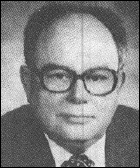
Kermit Kuck
However, despite Kuck's brilliant record, nagging problems with its unions continued to
hound Monarch. The 1970's were particularly bitter times for the company and the union.
The decade that followed meant new challenges in the form of foreign competition. However,
there had been tough years many times before. Each time, Monarch and its loyal employees,
with the help of a supportive community, had persevered. Monarch was again equal to the
task. Sales climbed to $140 million in 1981, and the manufacturing area was increased to
nearly 500,000 square feet.
With Kuck at the reins of the Monarch Foundation, scores of needy organizations and
individuals received a quiet helping hand. Kuck was particularly proud of the funding the
foundation provided to help launch the Friday evening Sidney Civic Band concerts on the
courtsquare.
The business success of the early 1980's proved to be short lived. In the years that
followed, increasing foreign competition took its toll. The sad story of the gradual loss
of business and the resulting reduction in employees that has developed since then is well
known. However, the special bond that existed between Monarch and our community continued.
Kermit Kuck spoke for Wendell Whipp and so many others when he described that relationship
on the occasion of Monarch's 75th anniversary. He stated: "The company and the
community have grown together. Monarch has contributed with its people and its financial
support...We are proud of our heritage, proud of our people and proud of our home. Monarch
has always had a deep sense of community and we will continue with our support.."
As Monarch faces its darkest hour, an anxious citizenry waits. Final decisions are
often made by people in far away places who understandably attach more significance to
money than memories. This grateful community, however, will never forget.
Update on Monarch
This
information is excerpted from an article that appeared in The Sidney Daily News on May 15, 1999
Monarch machine, located at 615 Oak Avenue, was founded in Sidney in June, 1909. The
company was sold in July of 1997 and the remaining Busch Division will relocate to
Milwaukee. Karl Frydryk, Monarch Vice President, said the relocation of the Busch Division
to Milwaukee will probably be finalized by the end of June or July, 1999.
[ Back to Industry Index ] |

